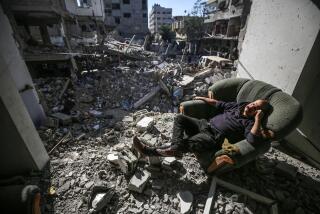The Berlin Wall, 20 years after the fall
- Share via
Reporting from Berlin — For almost 30 years, desperate East Germans tried to drive through it, tunnel under it and fly over it. More than 136 died in the attempt.
Less than two years after the Berlin Wall’s construction in the early ‘60s, it inspired President Kennedy’s “Ich bin ein Berliner” speech, galvanizing international attention.
In 1987, President Reagan stood in front of the Brandenburg Gate and demanded, “Mr. Gorbachev, tear down this wall!” which ran through the heart of Berlin.
The Berlin Wall, strung with 302 watchtowers along its 96 miles and featuring a “death strip” 30 yards wide, was a Cold War flash point and the symbol of a divided nation. Today, 20 years after it came tumbling down beneath a barrage of sledgehammers and pickaxes, the wall is still a potent symbol -- though now it represents peaceful revolution and reunification.
This fall is all about the fall
UPCOMING EVENTS
Nov. 9: The anniversary of the day the wall fell will mark the opening of the Festival of Freedom, centered around the Brandenburg Gate. Entertainment, food and wall-themed souvenirs will be available at street fairs on both sides of the gate. The highlight of the evening will be a multimedia symbolic staging of the fall of the wall using stones decorated especially for the event by young Germans and punctuated by a spectacular fireworks display.
Berlin is preparing to mark the anniversary of the wall’s fall with excursions, exhibitions and extravaganzas. As part of the planning, information columns in eight languages have been erected at major points along the route of the wall.
A $6-million, 100-mile-long biking trail called the Berlin Wall Trail has been built through the death strip that once divided the city. Tours that explore the sites along the trail include Discovery Tours WallGuide, GPS-guided tours that can be taken on foot or on bicycle and begin at Checkpoint Charlie. Historical photos, film clips and audio memories of survivors are accessible on the GPS interface.
Parts of the former East Berlin also can be visited with Underground Berlin, which offers tours featuring city bunkers, tunnels, vaults and subway systems.
Berlin on a Bike offers guided tours and live explanations along the wall trail. The route can also be explored by car in a Trabant, East Germany’s signature automobile, courtesy of Berlin’s “Wild-East” Trabi Safari, located near Checkpoint Charlie. This hourlong excursion includes the East Side Gallery, the longest piece of the wall still standing (0.8 mile), which features 106 paintings by international artists.
For a graphic taste of East versus West, spend a night at the Ostel Hotel in the Mitte District in the center of the city, followed by a night at the Adlon Hotel on the Pariser Platz.
Located in a concrete apartment block, the Ostel is a carefully re-created hotel/hostel from when Eastern Germany was in its prime. One night in the garishly decorated, Communist-chic rooms with plastic box radio and Stasi ghosts offers an authentic taste of life behind the wall.
At the other end of the scale, the elegant Adlon was once the grand dame of Berlin hotels and was the model for the classic Hollywood film “Grand Hotel” with John Barrymore and Greta Garbo. Badly damaged when Berlin was split, the hotel has been meticulously restored and its five-star Western luxuries overlooking the Brandenburg Gate offer a striking contrast to the austere Ostel.
Many of Berlin’s museums, such as Museum House at Checkpoint Charlie, the German Historical Museum, the Allied Museum, the Stasi Museum and the DDR (Deutsche Demokratische Republik) Museum, are all planning special exhibitions featuring the rise and fall of the Berlin Wall.
A free open-air exhibition, “The Peaceful Revolution,” documenting the reunification of Germany, opens in May at Alexander Platz, beside the World Clock. Throughout the year and at various locations around the city, theater performances, concerts and literary readings will focus on the end of the German Democratic Republic, reunification and 20 years of a changing Berlin.
More to Read
Sign up for The Wild
We’ll help you find the best places to hike, bike and run, as well as the perfect silent spots for meditation and yoga.
You may occasionally receive promotional content from the Los Angeles Times.






